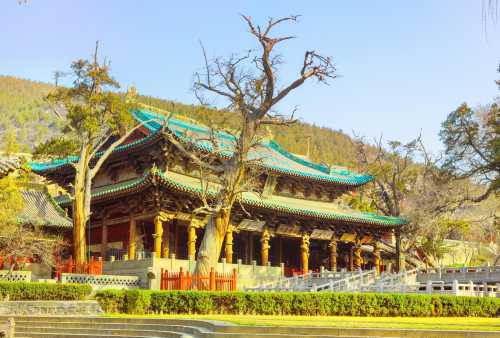Popular Trip Moments
InterContinental Hotel Taiyuan | Unique visual experience at the Taiyuan Chunyang Palace | Highly recommended hotel with an impressive stay experience | Take the high-speed rail to the Taiyuan Museum! | This hotel in Taiyuan is the right choice | Jinci Half Day Tour | Just got back! Newly opened hotels are the best to stay in | Taiyuan Kempinski, a Dream Palace Where Classical and Modern Luxury Intertwine | One of Taiyuan's hidden gems, Chunyang Palace will not disappoint | 9-Day Route through Linfen, Pingyao Ancient City, Taiyuan and other places | The fairyland around Taiyuan is beautiful and has few people but no tickets | Northern Qi Dynasty Mural Museum: 2-Hour Efficient Viewing Guide | Must-Stay Hotel Series: Seven-Day Stay at Sheraton Taiyuan is Worth Every Penny | Taiyuan丨I like new hotels with large areas | Taiyuan Casa Boutique Hotel, definitely worth staying at | Taiyuan Sunshine International Hotel, a recommended hotel for your stay experience | This hotel is fantastic! I'd love to come back again. | Tianlongshan: Explore Ancient Relics and Immerse in Poetic Mountain Scenery | My Best Hotel Stay in Taiyuan: Taiyuan Maoye JW Marriott Hotel | Shanxi Treasure Spots Grand Tour Guide | Great Value: Fairfield by Marriott Taiyuan South Railway Station | Must-stay new hotel! voco Taiyuan Longcheng Street | Pullman Taiyuan Fuli Hotel | Sheraton Taiyuan Hotel | Manxin Hotel (Taiyuan Longcheng Park) | After staying in 5 hotels in Taiyuan, this one made me want to extend my stay on the spot. | Come to Taiyuan - A Great Value Choice - Wanda Vista Hotel Taiyuan South Station | Found a Hidden Gem Hotel with Exceptional Value in Taiyuan | The Most "Low-Key" Ancient City in Shanxi, Taiyuan Ancient County Town, Rarely Visited by Tourists | Taiyuan, China: A City of Ancient Heritage
Popular Travel Types
Recommended Attractions at Popular Destinations
Bangkok attraction near me | Manila attraction near me | Tokyo attraction near me | Taipei attraction near me | Hong Kong attraction near me | Seoul attraction near me | Kuala Lumpur attraction near me | Los Angeles attraction near me | Shanghai attraction near me | New York attraction near me | Shenzhen attraction near me | Osaka attraction near me | Singapore attraction near me | London attraction near me | Guangzhou attraction near me | San Francisco attraction near me | Beijing attraction near me | Macau attraction near me | Bali attraction near me | Jakarta attraction near me | Paris attraction near me | Ho Chi Minh City attraction near me | Istanbul attraction near me | Phuket attraction near me | Chicago attraction near me | Seattle attraction near me | Toronto attraction near me | Orlando attraction near me | Cebu attraction near me | Chiang Mai attraction near me
Popular Restaurants in Taiyuan
Parkview Hotel | YIN XIANG GE | SHAN XI GUILD HALL | Bingcui Restaurant | LAO TAI YUAN KITCHEN | ShanXi HuiGuan (TaiYuan ShengLi East Street) | HAI DE LAO HUO GUO QIN XIAN BEI JIE DIAN | THE FOOD GALLERY OF BINGZHOU | LAO YUAN ZI | 梵 | 十月·情侣主题咖啡馆 | PING RIVER TASTE | LI WAI YUAN | 鱼酷活鱼烤鱼(柳北潮流汇店) | Shunhuafenguan (taoyuannanludian) | 向阳羊汤馆 | 德得轩自助烤肉(王府井店) | Shanxihuiguan (xutanxijie) | Daofulin Restaurant | 洲际酒店源·咖啡西餐厅 | Binheweidao (nangong) | XING HUA TANG | 呷哺呷哺(太原茂业店) | Xiao Chi Lin | DQ | 礼舍和牛火锅(南中环店) | 必胜客(亲贤店) | 虎丫炒鸡(龙湖万达店) | 鱼酷活力烤鱼(万象城店) | 奈九居酒屋(万象城店)
Popular Ranked Lists
Top 9 Local Restaurants in Manzhouli | Popular Luxury Hotels Near Fort William | Popular Best Things to Do in Shaoyang | Top 10 Local Restaurants in Jinghong | Popular Best Things to Do in Jieyang | Top 10 Local Restaurants in Emeishan | Popular Luxury Hotels Near Tatsugo | Popular Local Restaurants in Chongzuo | Popular Luxury Hotels Near Silivri | Top 10 Best Things to Do in Rongcheng | Top 5 Local Restaurants in Xuchang | Top 3 Luxury Hotels in Tashkent | Popular Luxury Hotels Near Taean-gun | Top 10 Luxury Hotels in Red Sea Governorate | Popular Luxury Hotels Near Fukushima | Top 5 Best Things to Do in Weinan | Top 3 Local Restaurants in Yulong | Top 3 Luxury Hotels in Dhaka | Popular Luxury Hotels in Dhulikhel | Top 10 Local Restaurants in Dayi | Top 10 Local Restaurants in Tengchong | Top 3 Luxury Hotels in Kavrepalanchok | Popular Best Things to Do in Xinyu | Top 8 Local Restaurants in Hanzhong | Popular Premium Hotels Near Geraldine | Popular Luxury Hotels Near Etretat | Popular Luxury Hotels Near Naxos | Top 10 Local Restaurants in Wuyishan | Popular Luxury Hotels Near Anand | Top 3 Best Things to Do in Linxia Prefecture
Payment Methods
Our Partners
Copyright © 2025 Trip.com Travel Singapore Pte. Ltd. All rights reserved
Site Operator: Trip.com Travel Singapore Pte. Ltd.
Site Operator: Trip.com Travel Singapore Pte. Ltd.














